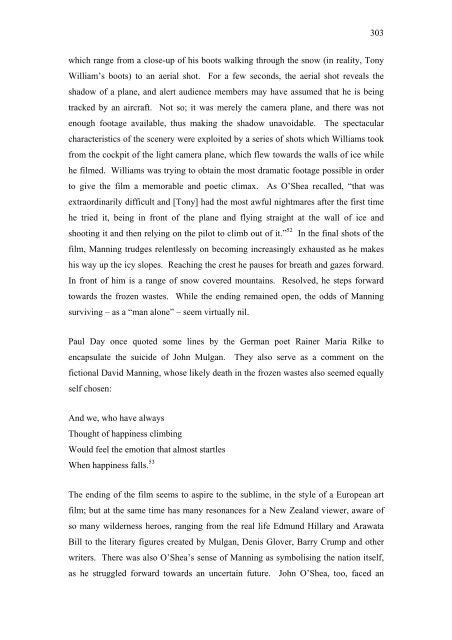Copyright Statement - ResearchSpace@Auckland
Copyright Statement - ResearchSpace@Auckland
Copyright Statement - ResearchSpace@Auckland
You also want an ePaper? Increase the reach of your titles
YUMPU automatically turns print PDFs into web optimized ePapers that Google loves.
303<br />
which range from a close-up of his boots walking through the snow (in reality, Tony<br />
William’s boots) to an aerial shot. For a few seconds, the aerial shot reveals the<br />
shadow of a plane, and alert audience members may have assumed that he is being<br />
tracked by an aircraft. Not so; it was merely the camera plane, and there was not<br />
enough footage available, thus making the shadow unavoidable. The spectacular<br />
characteristics of the scenery were exploited by a series of shots which Williams took<br />
from the cockpit of the light camera plane, which flew towards the walls of ice while<br />
he filmed. Williams was trying to obtain the most dramatic footage possible in order<br />
to give the film a memorable and poetic climax. As O’Shea recalled, “that was<br />
extraordinarily difficult and [Tony] had the most awful nightmares after the first time<br />
he tried it, being in front of the plane and flying straight at the wall of ice and<br />
shooting it and then relying on the pilot to climb out of it.” 52 In the final shots of the<br />
film, Manning trudges relentlessly on becoming increasingly exhausted as he makes<br />
his way up the icy slopes. Reaching the crest he pauses for breath and gazes forward.<br />
In front of him is a range of snow covered mountains. Resolved, he steps forward<br />
towards the frozen wastes. While the ending remained open, the odds of Manning<br />
surviving – as a “man alone” – seem virtually nil.<br />
Paul Day once quoted some lines by the German poet Rainer Maria Rilke to<br />
encapsulate the suicide of John Mulgan. They also serve as a comment on the<br />
fictional David Manning, whose likely death in the frozen wastes also seemed equally<br />
self chosen:<br />
And we, who have always<br />
Thought of happiness climbing<br />
Would feel the emotion that almost startles<br />
When happiness falls. 53<br />
The ending of the film seems to aspire to the sublime, in the style of a European art<br />
film; but at the same time has many resonances for a New Zealand viewer, aware of<br />
so many wilderness heroes, ranging from the real life Edmund Hillary and Arawata<br />
Bill to the literary figures created by Mulgan, Denis Glover, Barry Crump and other<br />
writers. There was also O’Shea’s sense of Manning as symbolising the nation itself,<br />
as he struggled forward towards an uncertain future. John O’Shea, too, faced an















